Hybrid City
Site: Elevator
THEME
Question: How to know a hybrid city from an elevator?
What makes a city hybrid? From Bruno, we know the city itself is a living creature. A city’s life combines time, light, and weather. It’s a creation of human activity. Human activity can be divided into two parts: private and public, which creates a hybrid city. Walking in a hybrid city, by focusing on the boundary between private and public, we can see people’s different actions in different places. People either stay in their private space or move around in public. It is a reflection of the city’s static and dynamic, respectively. The hybrid is the meaning of balance (static and dynamic) in the whole city. The overwhelming amount of neither private nor public space is good for the city.
The elevator is also a combination of privacy and publicity. In other words, it is a hybrid place too. The amount of people in this small space determines whether the elevator is private or public. As people move from time to time, an elevator is a hybrid place of private time and public time.
The elevator is a good space for this research.1 By focusing on the elevator, we have a new way to observe this hybrid city. We can simply stay in an elevator and observe the city’s vitality. During rush hours and lunchtime, you can see different people come in and go out. The small space around you is a public place. But when you take an elevator at midnight, you may face being alone in a “private” elevator. During one day, this kind of change in the elevator reflects the private-public balance in the hybrid city. It shows that this hybrid city is alive. But during the pandemic, it is more likely that you are the only one who takes this elevator today. The over-privacy of a place indicates the loss of dynamic in the building and the city. The city is sick now.
In conclusion, we can know whether a hybrid city is functioning normally by observing its balance of private and public. And an elevator is a good place for research because we can see the hybrid of the two in the same place at different times.
RESEARCH
I choose to conduct my research in my hometown, Beijing. In this modern city, you can easily tell the difference between private and public, as there are public workplaces and private houses everywhere. And it is convenient to find the elevator in these places.
To find out “how to know a hybrid city from an elevator”, I divided my research into two parts. The first part is to find out why an elevator is a hybrid place of private and public. And the second part is why it is related to the whole hybrid city.
To study the first part, I made a questionnaire to ask my schoolmates what they were doing inside an elevator. The answer strongly depends on whether they are alone or not inside the elevator. It reminded me that I could not only find the boundary between private and public from space but also from time. I can study the elevator at different times (standing with the crowds—public time, alone—private time) to find the change between private and public and prove it is a hybrid place.
As for the second part of the research, I found that there exists a balance between private and public in the city, and also in the elevator. By focusing on the pandemic period, I found that people ‘disappeared’ from the city’s public places due to the restriction of human activities, and the privacy of public places had increased. According to Akkelies van Nes, whether a place is private or public is determined by how individual lifestyle can affect the place. As fewer people appear in public places, the restrictions and rules decrease, the influence of individual increase, and the place becomes more private. The elevator is the same. During the pandemic, as fewer people choose to take elevators in the city, the balance between private time and public time inside the elevator has broken. It appears to be a similar situation of overwhelmed privacy. As a result, to study the whole hybrid city, we can use the time balance in the elevator to relate to the space balance in the city. If a city is under natural or human disaster, the disaster can likely break the balance between private and public.2
VIDEO
I tried to use different angles to enhance people’s feelings inside a hybrid elevator in this film. For example, I chose a low-angle when showing daydreaming in the elevator. I believe the low-angle can highlight the actor and make him look more self-centered, letting the audience know he is immersed in his thoughts. When filming the public time in the elevator, I believe the low-level camera focusing on shoes can increase the feeling of nervousness.
Also, there are many implications of the pandemic inside the film. Such as people wearing masks all the time. At the end of the film, a hand sanitizer is on the floor. It implicates that the pandemic decreases the publicity of the elevator and the hybrid city.
REFLECTION
I think I gained a deeper understanding of making a film from an idea.
First, as for the theme, I think the way to show a hybrid city is to analyze the city’s different features and their coexistence. I believe it requires effort to make comparisons between features and find their relations.
Also, during this research, I found that I have begun to notice something simple in the city which I had ignored before. (I used to think about a city from its space. This time the analysis of the elevator provides me with a new way to study the city from the ‘time’.) I believe this kind of finding is essential in conducting my research. It can always provide me with new ideas and make me creative.
Last, I think making a video requires more patience than taking a picture. I needed to wait for a long time to get good light and environment. And sometimes, I was interrupted by others. I have learned that every clip in a film needs to be polished many times.
FOOTNOTES
1: I conduct my research in two places: a private elevator inside my home and public elevators in a building.
2: There is another example of overwhelmed publicity. During wartime, private places are likely to be occupied or ruined by the army (individual action is hard to twist the bad situation). As a tool to transport people, elevators can be crowded all the time for evacuation purposes. We can see that public time is far longer than private time in an elevator.
Director: Lin Ronghan
Voiceover: Lin Ronghan
Film’s inspiration from: Dr. EUNICE SENG
Actor:
Ding Honglei
He Yuanyuan
Jia Yue
Li Xueying
Lin Ronghan
Qu Yan
Tang Jiazheng
Wang Chenchen
Wang Duanrui
Wang Meng
Wang Sudan
Yin Xin
Singer:
Wei Menglin
Special Thanks:
CMB
STORYBOARD

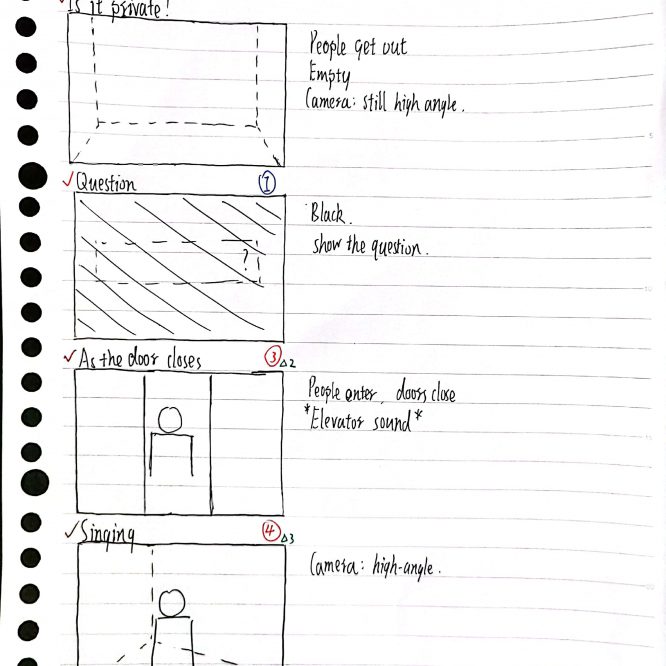

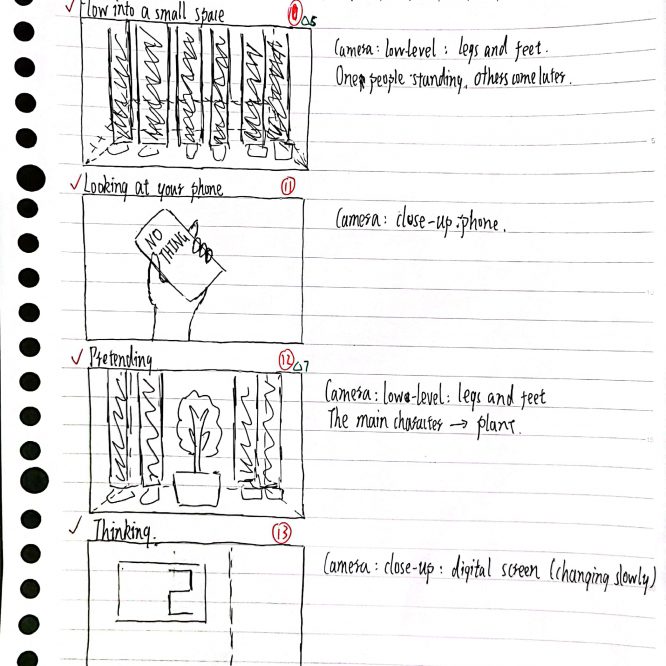
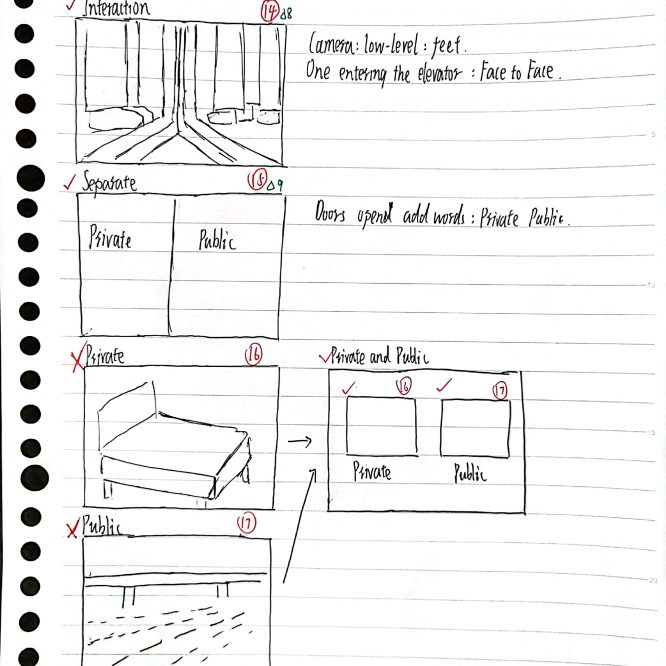

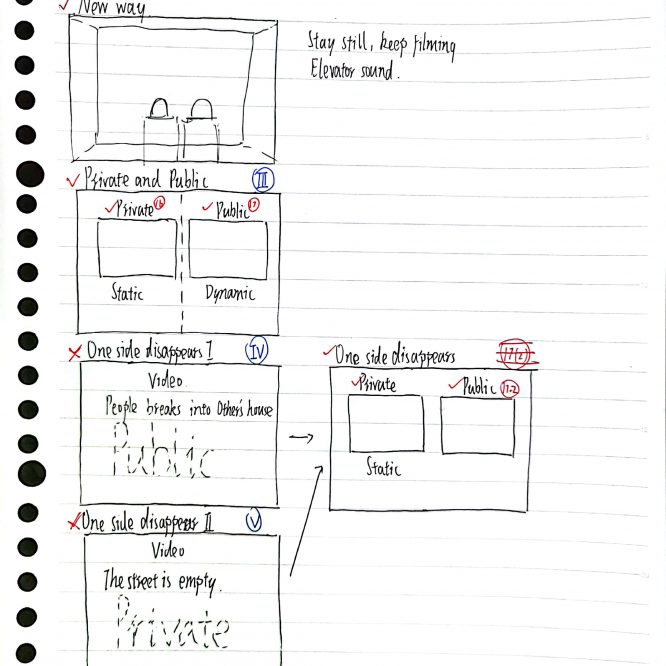
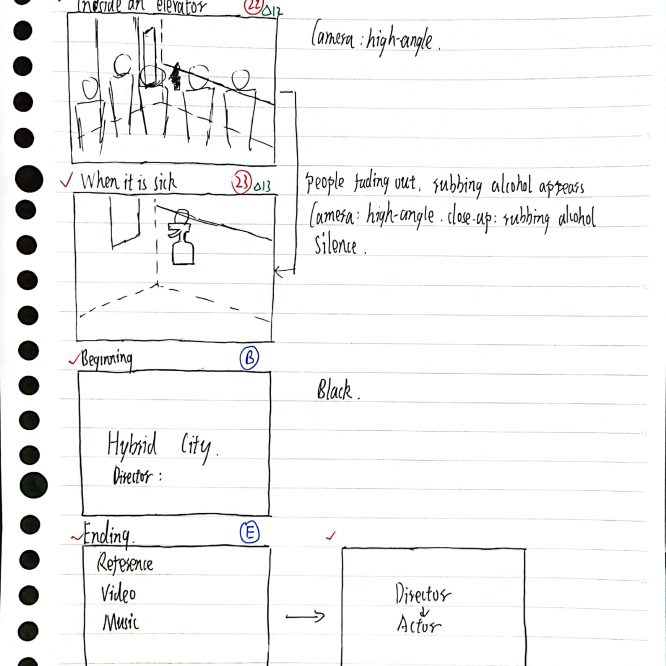
REFERENCES
Bruno, G. (2004). Architects of Time: Reel Images from Warhol to Tsai Ming Liang. Log, 2, (pp. 81-94).
Nes, A., & López, M. (2007). Micro scale spatial relationships in urban studies: The relationship between private and public space and its impact on street life. 6th International Space Syntax Symposium, 23, 1-12.
Background music: Livingstone, l. (2014). Valiant Hearts: The Great War [Online].
PICTURE REFERENCES
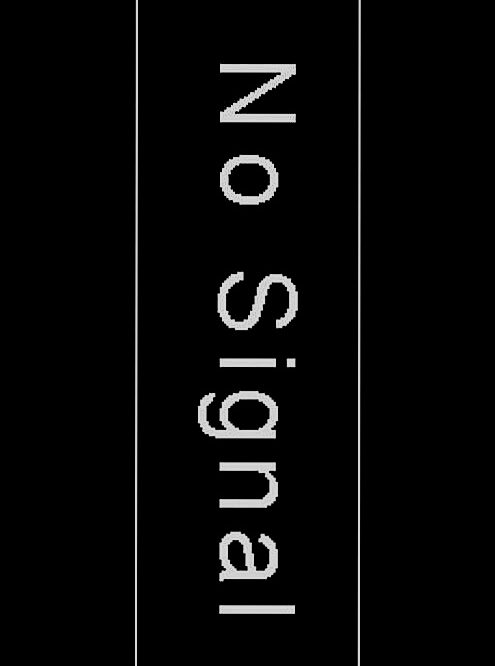
https://baijiahao.baidu.com/s?id=1671754137542522873&wfr=spider&for=pc
QUESTIONNAIRE: What are you doing inside an elevator?
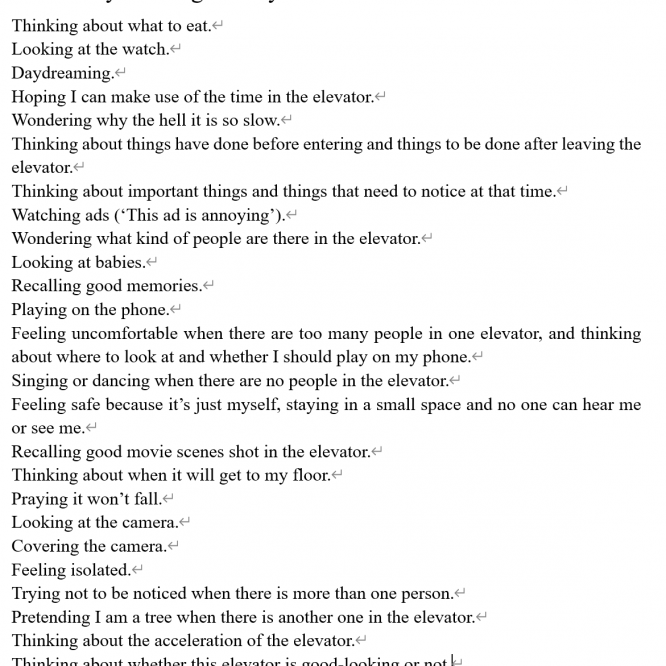
Answers from:
Allison Li
Chen Shuqi
Chen Xinyu
Lei Xinran
Song Yichuan
Su Zijian
Yuan Haocheng
Zhang Yuchen
Zhao Jingyao
Ronghan Lin 3035845980
Really engaging and comprehensive content. The use of interesting editing, shot composition and especially transitions elevates the film and its content, avoiding to become a mundane film with just standard elevator shots. The difficulties of directing and photographing complex scenes in elevators have been successfully overcome.
The themes and suggestions behind the hybrid “public” and “private” concepts, and also some underlining darker themes of a “sick” city, in my opinion allows for viewers to think over this film even after its runtime ended. Without explicitly mentioning “Covid” or its significant effects, and using more subtle story telling or dialogue to convey its effects.
Further creative use of text and interactions of characters or extras, enhance the overall narrative and themes of this film.
Thank you for your comment. I appreciate for your suggestion.
I love how you use the opening and closing of elevator doors as a transitional effect which is a clever visual design to emphasize the thin yet prominent line between private and public places divided by elevators. It is a refreshing idea of how places could be not clearly divided into totally public or totally private, but grey areas like elevators exist that “forces” us to “interact” with others- even though we do not have actual communication with one another in this small and suffocating space, our privacy is intruded anyways, making us feel awkward, not knowing how to position ourselves in this hybrid space. I also appreciate how you incorporate the idea of balancing private and public into this current pandemic, in which most of us are confined into private spaces, isolated from the public. Although some may find themselves more comfortable in a private space, it surely is detrimental to a city when public spaces are no longer dynamic.